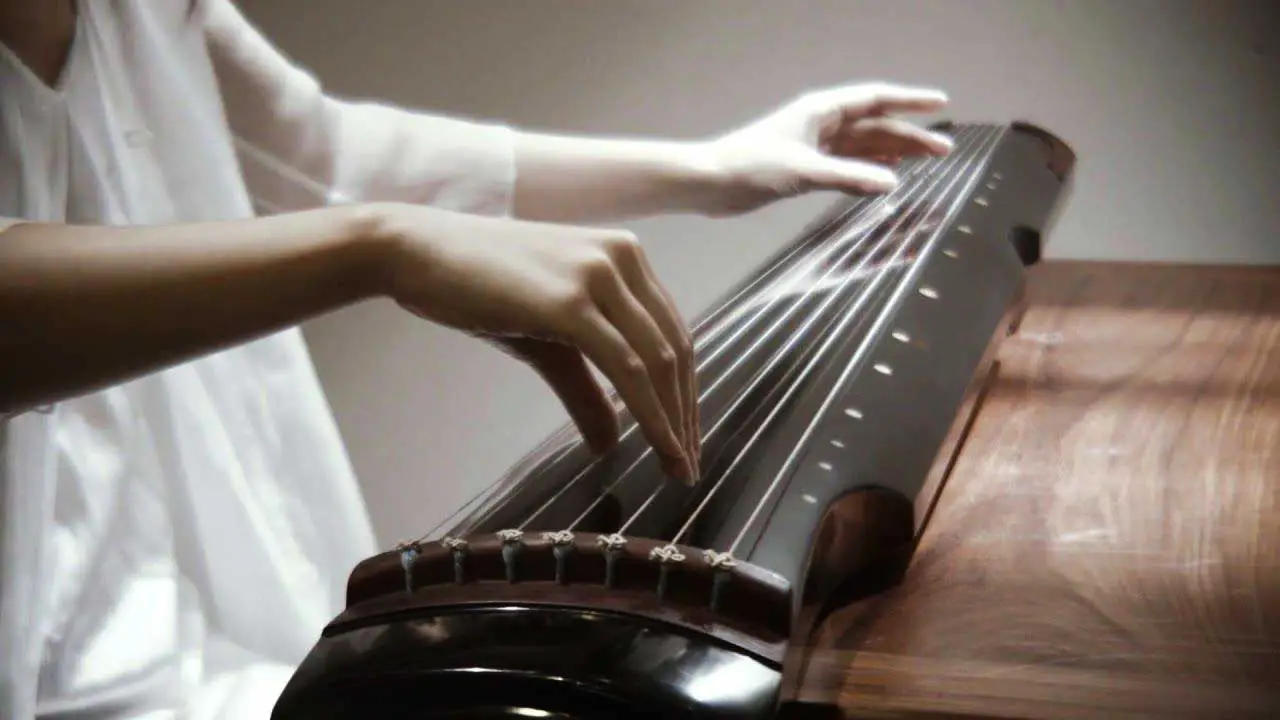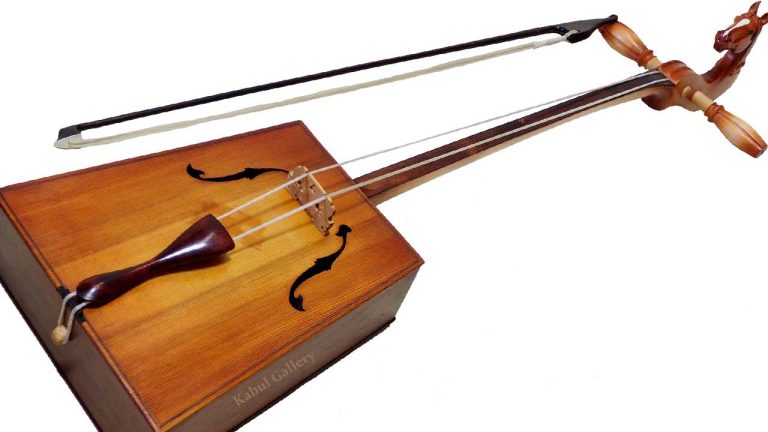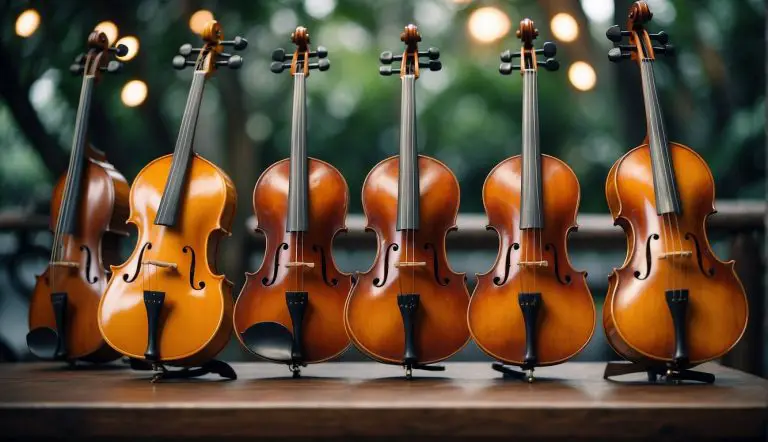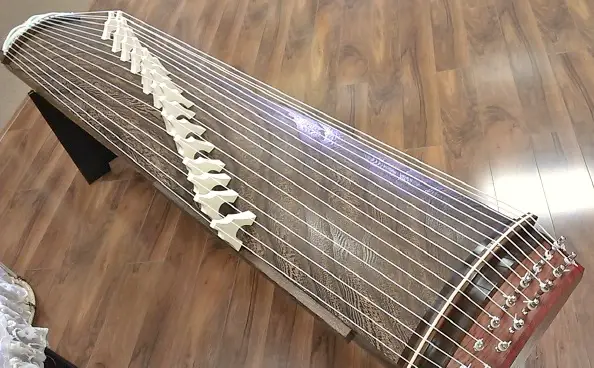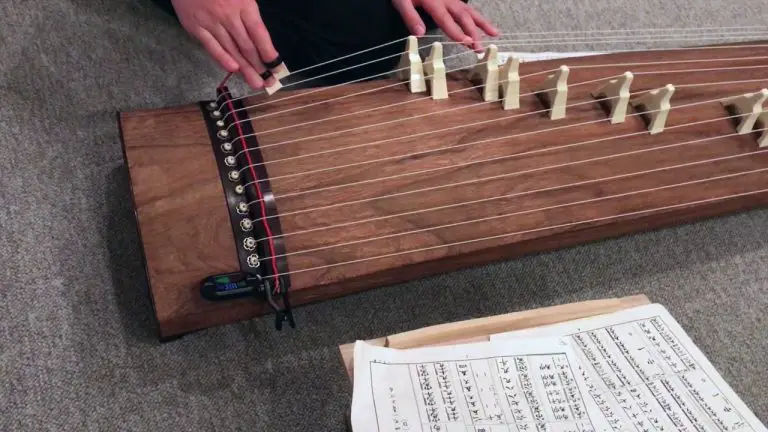Guqin Instrument FAQs – The Hidden Chinese Gem
Folkstrings.com is reader-supported. When you buy through links on our site, we may earn a small commission.
The Guqin is one of China’s oldest and most traditional musical instruments. UNESCO also recognized it as a World Cultural Heritage in the 2000s. Guqin’s fame is strongly connected to its strings that deliver a bass register with four octaves, producing a gentle and pure sound. Its strings are also longer than other Chinese instruments, adding to its unique features and rich-toned vibration.
- Authentic Guqin crafted from aged reclaimed Paulownia that has been Air Dried for more than 5 years
- Lacqured using traditional lacquer mixture
- Comes with Decorative Linen Guqin Carry Bag, Tuning Teasels, Tuners, Anti-Slip pads.
Go through this article to learn more about the guqin and its history.
Table of Contents
What Is the History of the Guqin?
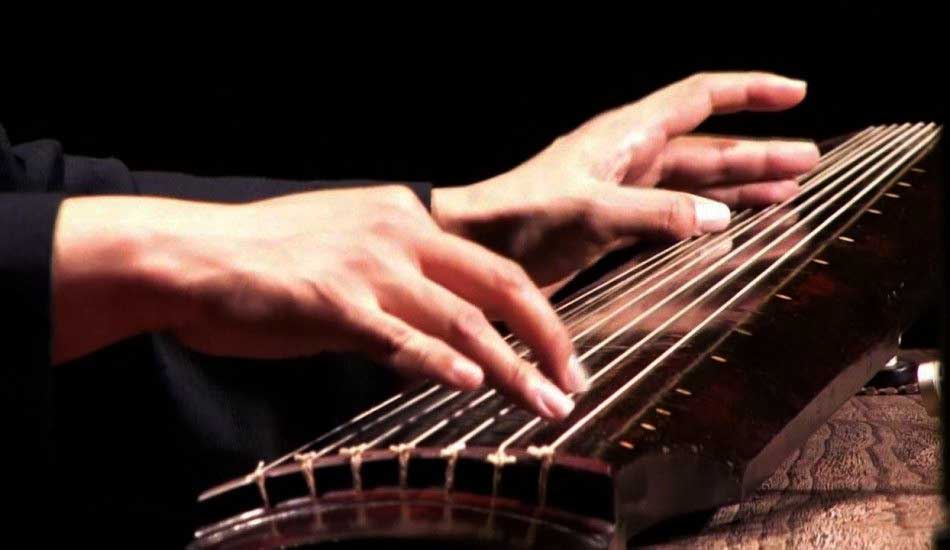
This Chinese zither, believed to have existed over 3,000 years ago, has many names. It’s also referred to as “the father of Chinese music” and is an “instrument of the sages.” Guqin is one of the four arts, along with calligraphy, painting, and ancient chess.
These arts are what Chinese scholars had to master. Playing the guqin was an elite art performed by the nobility, scholars, and literati in an intimate event, not for public performance. That was until Confucius introduced the guqin as an instrument that was not only used for academic purposes.
The guqin initially had five strings symbolizing fire, earth, water, wood, and air. However, emperors in later dynasties added two more strings to represent life events.
That’s why today’s guqin has seven strings stretched across a narrow wooden sound box usually made of paulownia wood or China fir. Its 130cm L x 20cm W x 5cm H size symbolizes 365 days, and the 13 jade markers on the edges represent each month of the Chinese calendar.
The two holes with different sizes at the base of the guqin are responsible for emitting sound: the small or dragon pond and the large hole called the phoenix pool. In ancient times, the guqin had twisted silk strings attached to a wooden box with pegs and goose feet to allow players to tune the instrument. Later, Chinese makers replaced the goose feet with a wrench, and most strings used today are nylon and steel.
Although the true origin of the guqin is still uncertain and the new generation is unfamiliar with the instrument, its popularity is gradually returning. After being recognized by UNESCO in 2003, more and more people of all ages have become interested in the guqin. Because of this, the guqin is now present in modern stage performances and different music genres such as rock and pop.
Is the Guqin Instrument Hard to Learn?
Yes, the guqin melody is difficult to learn and understand. You must have good fingering skills to pluck and stop the strings. These skills include picking, sliding, vibrating, and pushing strings to produce sound. You must also master the proper finger positions, tuning, and stroke techniques to create a pure tone.
As a beginner, you must study three basic guqin playing techniques:
- “San” or open sound
- “Fan: or harmonics, and
- “An” or stopped strings
Players use “san yin” to produce a clear sound for important notes using their right hand. In “fan yin,” the left hand lightly holds the string in the correct position while the right hand plucks the strings to produce a light floating tone. Like “fan yin,” players also use both hands to play “an yin,” but the left hand is firmly pressed or sometimes slides across the strings to create different tones and vibrations.
Regardless of the technique used to play the guqin, the music should not just be entertaining but also inspiring and soothing.
Could You Teach Yourself How to Play the Guqin?
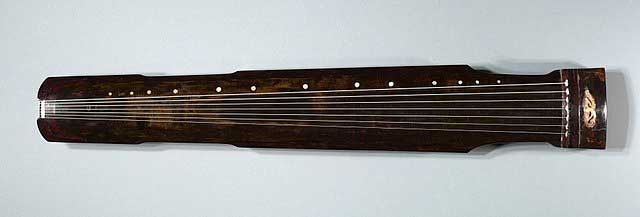
You can, but only the most basic. With the help of guqin players posting tutorials on online platforms like YouTube, you can now learn on your own. By watching these videos or reading books, you can get different beginner techniques and tips on becoming a good guqin player and effectively connecting with your audience. It also helps the community of guqin players to cater to more audiences, as nowadays, the number of guqin masters is dwindling.
However, you’ll be sacrificing the benefits you can earn from training with a master. It’ll also be more challenging to spot and correct mistakes. Also, teaching yourself will take you more time to learn. Here are some problems beginners usually encounter:
- Difficulty in reading the notated score
- Imprecise finger techniques
- Challenge in studying classical or traditional style
- Limited playing habits
If you’re studying for fun, it’s okay to teach yourself. But if it’s for a competition or you want to take guqin playing seriously, the best way to learn is by enrolling in classes with a guqin master. It can be face to face, through online courses, or you go to China and train.
What Different Types of Guqin Are There?

There were three main types of guqin in ancient times: the man-made qin of the sage, made by literati, and the guqin made by the emperors.
Over time, more styles developed:
- Zhongni Style
Zhongni is one of the most popular, simple, and elegant guqin styles named after Confucius. It falls under the man-made sage. The only decoration in this type is the two concave lines on the waist and head of the instrument. Its gentle, smooth, and excellent shape best reflect Confucianism’s modest and introverted style.
- Shennong Style
It’s believed to be Emperor Shennong’s work, but concrete evidence is still lacking. The bend at the bottom of the instrument makes it look ancient.
- Fuxi Style
It’s another popular guqin style similar to the Shennong. But in this type, there are two continuous bends in the lower part of the instrument. It’s the famous and elegant guqin of the Tang Dynasty.
- Louxia Style
It falls under the category of man-made literati. The name reminds people of endless views and breathtaking sunsets. Its edges have a continuous curve that resembles sea waves.
- Banana Leaf Style
It’s another man-made literati guqin. As the name suggests, this style looks similar to a banana leaf. This style is the most challenging guqin to make because it can create a perfect sound.
- Lianzhu Style
Lianzhu is a guqin with three continuous curves at the neck and waist. This type produces a rich and harmonious sound that professional guqin players mostly use. It’s speculated to be from the Sui Dynasty.
Although there are many different types of guqin, most makers produce the most popular style. Not only because they’re easier to do but also because changing the guqin’s shape will affect its sound box’s volume. Additionally, makers don’t want to confuse new guqin players with new and unusual styles.
How Much Does a Guqin Cost?
Guqin is an expensive string instrument. Depending on the style, material used, and level of expertise, the estimated price for a brand new guqin ranges from $300 to $3,000. When you buy an original and new guqin, you can get free accessories like:
- Carrying case
- Cloth guqin bag
- Cleaning cloth
- Anti-slip mats
- Tassels
- Electric tuner
- Cleaning brush
- Guqin tutorial book.
If you want to buy a cheaper guqin, try to find it in stores that sell second-hand instruments. Auctions are also a good source of original or vintage guqins in good shape, but they come at a high price. For example, Emperor Huizong’s guqin of the Song Dynasty (the wealthiest dynasty in China) sold for $22 million in 2010.
Which Is Easier to Learn, Guqin or Guzheng?
Guzheng is not only easier to learn than guqin but also cheaper. Like the guqin, the guzheng looks like a piano but plays like a guitar. The only difference between these two instruments is their strings and size.
Guzhengs have:
- 16 to 26 strings
- Are larger than guqins
- Have movable bridges
Note that despite its strings, the guqin can produce the sounds created by a guzheng.
Most players of both instruments say that while guzheng is simpler, especially for beginners, it gets complicated as you try more advanced techniques. On the other hand, it’s hard to learn guqin, but it’s faster to find masters and quickly absorb fingering skills.
If you can’t pick between learning guqin and guzheng, choose according to your preferences and skills. Remember that it doesn’t matter how hard or easy it is to study an instrument. If you’re not serious and patient, it will take longer and harder for you to learn.
Do You Need Nails for Guqin?

Using nails with guqin will depend on the player. It’s fine if you’re comfortable without using nails. However, serious guqin players who want to play grow their nails.
There are different opinions about fake nails because some say they are slippery and don’t contribute to a good performance. In contrast, others say that guqin players should invest in fake nails.
Remember the following when trimming your nails:
- Nails on the right hand must be two to three mm long. The edges must be round.
- Trim the left side of your thumbnails.
- Entirely trimming the nails on the left hand helps to press down on the strings.
What Is the Guqin Similar To?
Guqin is similar to another string and a more modern instrument called lap steel slide guitar. These instruments can produce similar sounds. The way to play these two instruments is also the same, with the musician sitting down and the fretboard facing upwards. Additionally, the techniques used in the guqin, like plucking and sliding up and down, also resembles how guitarist play slide guitar across their lap.
Conclusion
Investing in a guqin is an excellent idea if you want to learn to play traditional stringed instruments. It’s expensive and hard in the beginning, but so are most instruments. Playing guqin also means you have the chance to reintroduce traditional music and instruments that are on the brink of being forgotten.
Author Profile
-
Daniel Johnstone is an English writer with a love for stringed instruments from around the world.
He shares his love for these instruments through his writing for folkstrings.com, a website dedicated to all things related to folk string music.
Daniel's passion for music started at a young age, and he has since become an accomplished musician, playing guitar, cavaco, and recently, the harp.
His dedication to learning and sharing his knowledge of stringed instruments is evident in his insightful and engaging blog posts. Whether you're a seasoned musician or a beginner, Daniel's writing is sure to inspire and entertain you.
When he's not playing music or writing, you can find Daniel exploring new instruments and seeking out new sounds to share with his readers.
Latest entries
 AutoharpApril 4, 2024What Is the Autoharp Made Of: Exploring Its Materials and Craftsmanship
AutoharpApril 4, 2024What Is the Autoharp Made Of: Exploring Its Materials and Craftsmanship AutoharpApril 4, 2024Is Autoharp Easy to Play? Unveiling the Truth for Beginners
AutoharpApril 4, 2024Is Autoharp Easy to Play? Unveiling the Truth for Beginners AutoharpApril 4, 2024What Is an Autoharp Worth? Your Guide to Pricing and Value
AutoharpApril 4, 2024What Is an Autoharp Worth? Your Guide to Pricing and Value AutoharpApril 4, 2024Are Autoharp and Zither the Same Thing? Unraveling String Instrument Myths
AutoharpApril 4, 2024Are Autoharp and Zither the Same Thing? Unraveling String Instrument Myths
Affiliates:
This post may contain affiliate links that at no additional cost to you, the site may earn a small commission. We only recommend products we would use ourselves and all opinions expressed on this site are our own.
Accuracy Advice:
While we strive to provide up-to-date and accurate information, the content in this article may not reflect the most current research or medical guidelines. We encourage readers to do further research and consult with professionals for more personalized advice.
Our Recommendations:
The products and services mentioned in any of our articles are recommended based on our independent research and personal experience. We are not sponsored by any company. We aim to suggest products and services we believe are of high quality and could be beneficial to our readers.

